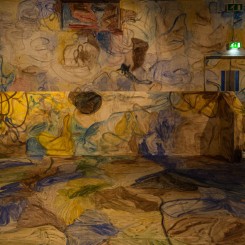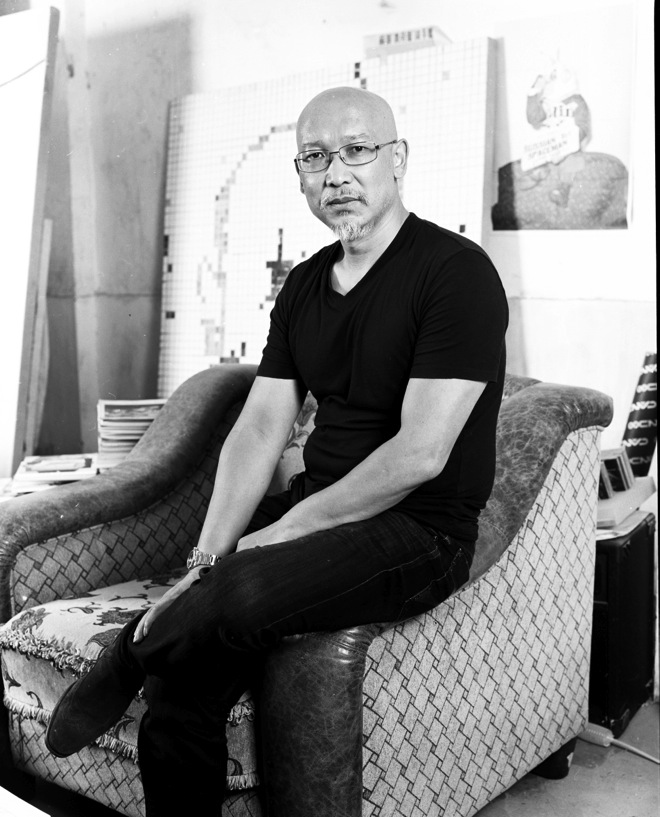The ICA (Institute of Contemporary Arts) in London was founded by a group of artists including Roland Penrose and Herbert Read in 1946. Today, the ICA continues in its founding aim to support living artists and show their work. Its reputation is as a pioneering, experimental venue and a host not only to art but also music, film and discussions on contemporary creative culture. This month, Shanghai-based artist Zhang Enli has created a “space painting” in the ICA theatre. In the run-up to the opening, Iona Whittaker spoke to ICA Director Gregor Muir about his discovery of this artist’s work, his first trips to China, Zhang Enli’s practice and his hopes for this solo exhibition in London.
About a decade ago, I was on the panel for a jury prize panel with Carolyn Bourgeois. We had our eye on a similar form of video, and it was exemplified by artists coming from behind the former iron curtain and the former Eastern bloc. Yang Fudong had made an enchanting pop video which involved three screens and a song which he had apparently written. We loved it, so off I went to find this gallery called Shanghart that was lurking somewhere in the depths of FIAC and who represented this unknown artist from Shanghai. When I got to this booth, it felt like a broom cupboard, but somehow they had managed to hang a tree painting by Zhang Enli.
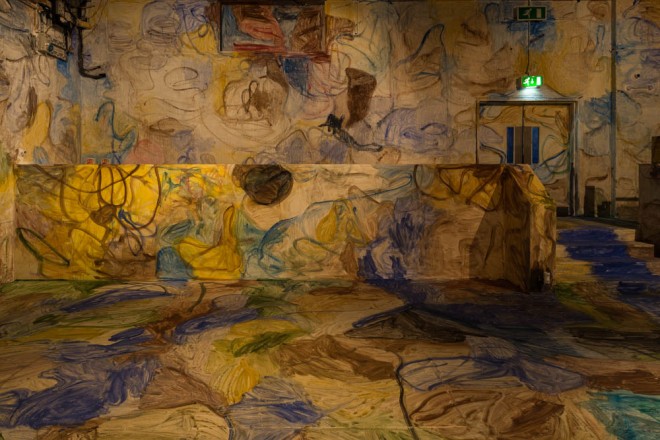
“Space Painting”, watercolor on wall, installation view, Institute of Contemporary Arts, London, 2013. © Zhang Enli, courtesy the artist, Hauser & Wirth and ShanghART Gallery. Photo: Mark Blower.
《空间绘画》,墙上水彩,展览现场,伦敦当代艺术学院(ICA), 2013
I had never seen one of these before. It’s a greyish, greenish tree painting with a yellow signature, and I remember thinking it was particularly beautiful. What was really challenging about it was that it looked as if it could have been anything from the turn of the last century—the Belle Époque period. It was somehow oddly modern. Everything about it stylistically seemed to indicate that it was not of our time. I became obsessed by it, and wondered why. I think there was a technical quality that I liked, for instance, the thin use of paint and the fact that you can see so easily the gridded nature of it. This extraordinary attachment developed to that one work, and I went back to look at it a few times. I just couldn’t understand why it was, amid all the conceptual or minimal-inspired contemporary art, that I liked this painting of a tree.
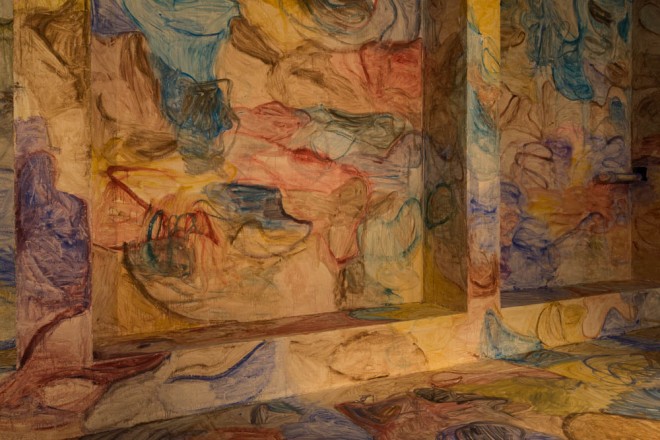
“Space Painting”, watercolor on wall, installation view, Institute of Contemporary Arts, London, 2013. © Zhang Enli, courtesy the artist, Hauser & Wirth and ShanghART Gallery. Photo: Mark Blower.
《空间绘画》,墙上水彩,展览现场,伦敦当代艺术学院(ICA), 2013
It struck me that I needed to keep an eye on Zhang Enli. This led to me going to Shanghai, by which time I had already known the work for some years. I had felt inspired by it and had discussed it at Tate, where I was working. At the time, the only people talking about Chinese art that were people I’d met through the auction houses; they were the only ones who had any sense of what was going on. Of course, at this point, the Centre Pompidou was putting on shows that included people like Yang Fudong. It transpired that I went to work for Hauser and Wirth gallery, and I told the owner I had seen a Chinese artist who I felt was coming from a very different position.
In China, I spent five, six days every day in Zhang Enli’s studio, going through every painting he’d ever made. I measured them all up—I don’t know quite what I was doing, but it must have seemed like the undertaker had come! I was sort of sizing him up—I’d never met him and I’d never been to Moganshan (art district) in Shanghai; I had no idea what I would find. Out of the many times I went to visit Enli over the years, I always seemed to bring the rain. We’d sit in his cold studio—a converted workshop—and he was painting mainly the items there. He’d been through a period of quite expressive paintings—a neo-expressive period of his production which was lurking in one of the back rooms. These were the paintings of people eating, the bald men. I started to realize that what he had done was capture the spirit of the restaurants the workers were frequenting; he had caught the tail end of a communist era in the truly Maoist sense—that was his interest. He was interested in public toilets, public swimming pools, wash basins and in these rough old Shanghai figures who were smoking. He seemed to have a certain style of painting which, in my view, he shared with people like Peter Howson and some of the, say, “post-punk” painters in Europe—there were touches of Immendorff or of people like Tony Bevan. But Zhang Enli seemed to have got to a point in his production where he was just leaving the ’80s—even I hate to say it—though it was quite definitely not the ’80s anymore. But if you were to put his work in a room with other European paintings of the ’80s, you’d have to have a very discerning eye to notice that the characters in the paintings were essentially Chinese and very much of a kind of ilk—they were the butchers and the dark horses of the city, I felt that was interesting.
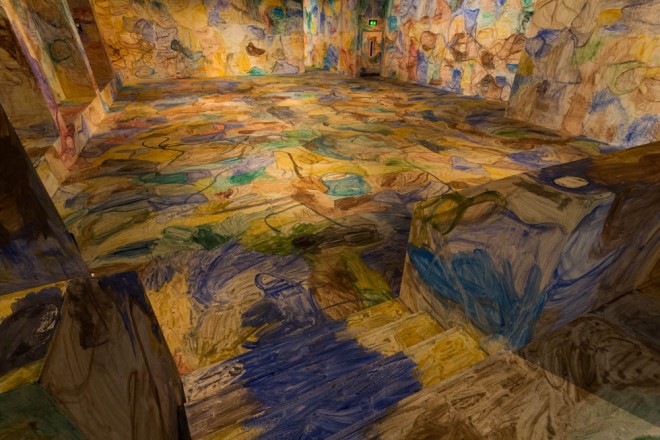
“Space Painting”, watercolor on wall, installation view, Institute of Contemporary Arts, London, 2013. © Zhang Enli, courtesy the artist, Hauser & Wirth and ShanghART Gallery. Photo: Mark Blower.
《空间绘画》,墙上水彩,展览现场,伦敦当代艺术学院(ICA), 2013
But what really felt began to take him away from this were the tree paintings and the beginnings of these paintings of public, communal spaces. We had long chats about it because he was then prone to painting just the things sitting around him. I didn’t realize until some years later that the paintings of trees were mostly gridded up from photographs, and that the photographs were of those trees taken in a period where these particular trees are not very important. They are near his studio—just average trees, even by Shanghai standards. What I realized and which I quite liked was that there was a sense of looking up, and a sense of looking at trees. On one hand, you realize he’s rarely made paintings of Shanghai as a cityscape—to my knowledge he’s only done it once—it’s always a detail or at night or something. But he was always a recorder, and he didn’t know it. Forgive me for saying this, but he just got on with it. He was a basic, wonderful guy who just painted. He’d been painting in that studio—as I understand it he got to Shanghai in the late ’80s or early ’90s, found the studio and just carried on. He was very persistent; he just wanted to paint. That came across. He was painting boxes that he found in the space and it all started to point to one thing—he was clearly fascinated with containers.
I was always interested because the trees have become a document of Shanghai. You’re looking up at sky where there are no buildings—it’s all about voiding the place. It’s as if you are looking directly up, which you do get in later paintings, and you get to the point where there is in fact no city. I think that was something that set Zhang Enli apart. He shares this with Yang Fudong in creating an ambient recording of everything around them; at the same time, they had really started to document the phenomenal change in the city. It changed beyond any recognition. They didn’t just have culture shock, they had culture trauma. And it may have sounded fun and great at first and it may have opened the doors and it had let people in, so they were relieved. You know, they weren’t just locked away anymore. I think Zhang Enli’s “cosmology” has really extended, and it was interesting to trace the development of Shanghai through his paintings. Interesting and odd for me was the connection between Shanghai and Europe, because it had been a far-flung European outpost. I remember feeling that it was being uncovered. You’d turn a corner and it was like old Europe. One is reminded of the Chinoiserie period in the European modern tradition which was being taken from China and Japan and fetishized as Asian. I feel that Enli is like Warhol selling America back to itself—it’s very clever. The day that I saw that tree painting and was wondering why it was so interesting and modern and so on—I now equate that with the idea that he is actually selling European modernism back to Europe. It’s as if he’s found this hidden, locked-away zone in which he’s managed to rescue the memory of a place and a tradition which he’s brought back. The thinness of the paint also very much recalls ink calligraphy. He would always give me calligraphy books that he was inspired by, and in certain cases he would be using those big ink brushes to do the leaves.

Zhang Enli, “Open and Close”, Space Painting, Watercolour on wall, Installation view, Gwangju Biennale, Gwangju, Korea, 2010
张恩利,空间绘画,墙上水彩,展览现场,印度,2010
Enli had to learn painting through a graphic school and whatever art magazines he bought. He once produced for me a pile of art magazines, the only art magazines you could buy were those that were literally showing you how to paint. But all the illustrations of western paintings were in black and white and terribly reproduced. It would be a very blurry odd section of a Van Gogh that hardly made any sense in anyone’s language. There’s a great painting by Enli called “Western Painting” which is a painting of a painting—he was almost pointing to the exotic nature of those works in his culture which until then had been so limited. I remember he was feeling low a few years later, because the changes were just too much, I think. If you are working on the grounds that there is an everyday, you need an everyday to be there every day, and Shanghai wasn’t. Shanghai was losing any sense of the everyday because the only constant was change. I think in a way that that eked into Zhang Enli’s subject matter, which was itself eking away. Shanghai was an underground scene that seemed to have a real edge to it. It had a heart and a pulse—it wasn’t manufactured. It was real, and I think people may want to revisit Shanghai in that first decade of this century, if not the ’90s, because what happened there is important.
I think this space painting exhibition at the ICA will be very interesting; it’s an area of his work that I haven’t worked with before. The first one he did was in Antwerp at Objectif, and he’s been painting them in India and Sao Paolo. Here, I feel we are returning to his earliest ones, which means painting an existing room, and a room into a space. It seems it will be totally abstract. It has a colorful, patchy, almost camouflage look at the moment, and I’m interested to see that. I’m also very interested in his painting in a former theater, which is now used for so many types of displays and events. The fact that it’s in this theatrical space I think will be very interesting because I think people will look at the type of work he’s making as a set or as a kind of performative painting. There is a theatricality about those space paintings, so the setting I hope will be very interesting and fitting. But your immediate experience, of course is that you walk through the picture plane as an act of sort being inside a painting. He will paint the floor as well. The painting will really inhabit the place; it doesn’t preclude or stop any activities happening within it—we may well have events in there, and those will happen “within” a painting. This abstract approach is also still capable of not being seen as just set-painting. There is something so decisively painterly about it. It’s a vast space, though he’s a fast painter, and so dedicated.

Zhang Enli, “Open and Close”, Space Painting, Watercolour on wall, Installation view, Gwangju Biennale, Gwangju, Korea, 2010
张恩利,空间绘画,墙上水彩,展览现场,印度,2010
It was a consideration how this work would fit into the landscape of Chinese art being shown in London at the moment, and in terms of what audiences have been seeing. Of course, the ICA aims simply to show “contemporary art,” rather than art from specific locations. We are very careful about “flag-waving” shows, to be point where we don’t really do them. The key thing this time is that we felt we had an opportunity to do something in this particular space and with this particular artist which has felt timely. We wanted to balance the program and to shed some light on artists like Zhang Enli who will begin to broaden our horizons. I don’t see emerging economies as necessarily generating good art. I think—and it’s not a pat on my back or ICA’s back—that it’s good when we follow someone like Zhang Enli. It’s a sustained curiosity. I hope this exhibition something will bring him back to life in the UK for good reason. I feel he is one of the lasting Chinese artists.
ICA (Institute of Contemporary Arts, The Mall, London SW1Y 5AH, UK), Oct 16 – Dec 22, 2013



